Tywyn, formerly spelled Towyn, is a town and seaside resort on the Cardigan Bay coast, in the historic county of Merionethshire. It is famous as the location of the Cadfan Stone, a stone cross with the earliest known example of written Welsh, and the home of the Talyllyn Railway. Tywyn Church is dedicated to St. Cadfan, and contains the original town war memorial, in the form of the Church Porch, which was erected by its Parishioners to commemorate the fallen of the Great War, 30 soldiers and a nurse, whose names are listed on marble tablets. An additional granite tablet was then added following the end of the Second World War, to commemorate the nineteen fallen of the latter war. There is another, newer, memorial in Tywyn, situated in the Memorial Gardens, which was opened in 1990, and also includes the details of the fallen of all of the neighbouring Parishes. This page commemorates those listed on the St. Cadfan’s Church memorials, while the photo below is of the memorial in Tywyn memorial gardens.
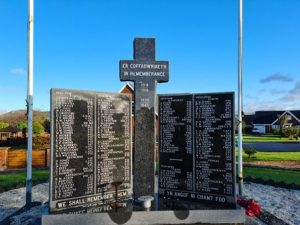
The Great War, 1914-1918
John Elgar Beckingsale, Second Lieutenant, Duke of Cornwall’s Light Infantry. John was born in Vancouver, Canada on 17 November 1887, the son of Dr Daniel Loftus Beckingsgale and Amy Florence Beckingsgale (nee Smith). John graduated from Ontario High in 1907 and attended Pomona College, before becoming a U.S. citizen in 1911, and settled in California. His mother was killed by a train on 27 April 1916, so his father moved to Tywyn, gaining the position of Medical Officer for Tywyn and District. On 23 August 1916 John arrived in England, and enlisted into the 28th Battalion, London Regiment (Artists Rifles). John was commissioned from the Artists Rifles into the Duke of Cornwall’s Light Infantry soon afterwards, and was posted to the 6th Battalion, DCLI, which was attached to 43 Brigade, 14th (Light) Division. He probably joined the battalion after its move from the Somme sector to Arras early in 1917. The Division took part in heavy fighting during the Battle of Arras, before moving north to the Ypres Salient during July 1917, and spent some time training behind the lines before moving into the battle area. The 6th DCLI was allotted the front from the southern edge of Glencorse Wood to the Northern edge of Inverness Copse, taking up positions there by 22 August, and the battalion was tasked with strongpoints by Fitzclarence Farm and Jargon Trench. The battalion attacked behind a rolling barrage on the following morning, 23 August 1917, supported by a lone tank, capturing a concrete emplacement and numerous machine-guns and prisoners. John was killed almost as soon as the attack began, reportedly shot through the head whilst leading his men. The 31-year-old has no known grave and is commemorated on the Tyne Cot Memorial, Belgium.
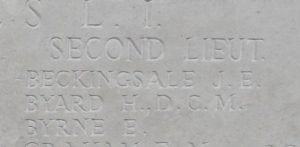
Charles Campbell Davies, Driver, W/1359, Royal Field Artillery. Charles was the son of Owen and Anne Davies, of Tywyn. He married Annie Jones at Dolgellau in 1906 and the couple moved to Mirion House, Gelly Road, Glanamman, where Charles worked as a plasterer. He enlisted at Aberdare into the Welsh Divisional Artillery and served in France with D/122nd Brigade, Royal Field Artillery from 24 December 1915. Charles saw action at Mametz Wood with the Welsh Division the following year and also took part in the artillery support for the divisions’ assault on Pilckem Ridge. He was killed in action during the Battle of Langemarck on 16 August 1917, aged 31, and is buried in Bard Cottage Cemetery, Belgium.
Evan Morgan Davies, Private, 9003, Machine Gun Corps. Evan was born in Tywyn in 1888, the son of Evan and Sarah Davies. By 1911 Evan was living at 30, Moy Road, Aberfan, where he worked as an underground timberman. He enlisted at Merthyr into the 13th Battalion, Welsh Regiment soon after the outbreak of war and was posted to Colwyn Bay for training. The battalion was attached to 114 Brigade, 38th (Welsh) Division, and embarked for France. Evan did not embark with the battalion, but remained behind, probably at Kinmel Park, and was later transferred to the Machine Gun Corps. He was posted to the 48th Battalion, Machine Gun Corps, which was formed in February 1918. Evan had not been long in France before he was wounded, and he died of his wounds on 3 March 1918, aged 30. He is buried in Tincourt New British Cemetery, France. Evan is also commemorated on the Aberfan memorial.
James Edward Davies, Bombardier, 11269, Royal Field Artillery. James was the son of John and Jane Davies, of Tywyn. He lived at 6, Dunraven Place, Ogmore Vale prior to the war. James enlisted at Cardiff into the Royal Field Artillery, and was posted to France on 6 October 1914 attached to the 35th Brigade, Royal Field Artillery. The Brigade was attached to the 7th Division, and landed at Zeebrugge, but the City was falling to the Germans, so the Division moved to Ypres and became the first British Division to hold the city. The Division then fought during the First Battle of Ypres, helping stop the German advance through Belgium and in March 1915 fought at the Battle of Neuve Chapelle. During May they fought at the Battle of Aubers Ridge, and at Festubert, before taking part in the Battle of Loos in September. James then transferred to C Battery, 149th Brigade, Royal Field Artillery, which was attached to the 30th Division. The Division had moved to France in November 1915 and saw its first major action during the Battle of the Somme. James was wounded on the Somme, and evacuated to No 1 Canadian General Hospital at Étaples, where he died of his wounds on 19 October 1916, aged 39. He is buried in Étaples Military Cemetery, France.
Hugh Pugh Ellis, Private, 291501, Royal Welsh Fusiliers. Hugh was the son of Griffith and Susanah Ellis, of Tyn-y-Cornel, Tywyn. He worked as a farm labourer prior to enlisting at Tywyn into the 7th Battalion, Royal Welsh Fusiliers on 14 December 1915. He was then posted to Wrexham, before being posted to Park Hall Camp, Oswestry for his training. On 3 July 1916 Hugh embarked at Devonport for Egypt, and joined the 1/7th Battalion, Royal Welsh Fusiliers, which was attached to 158 Brigade, 53rd (Welsh) Division. The Division had been evacuated from Gallipoli in December 1915, moving to Egypt to join the EEF, and helped guard the Suez Canal before taking part in operations to drive the Turks out of the Sinai. The EEF then turned its attention onto driving the Turks out of Palestine, and on 26 March 1917 launched its first offensive against the coastal city of Gaza, which guarded the road to Jerusalem. The assault failed, and a second attempt on Gaza was launched on 17 April, which again failed. As a result, the EEF was re-organised, with a change in leadership, and on the night of 1 November 1917 a third assault was launched, on a broader front running from Beersheba to Gaza. This time the EEF was successful, and the door was now open to capture Jerusalem the following month. During 1918 the 53rd Division took part in the advance north of Jerusalem, and saw the war out in Palestine. Hugh almost survived the war, but on 17 October 1918 was admitted to the 47th Stationary Hospital in Gaza, where he died of pneumonia and malaria on 19 October 1918, aged 34. He is buried in Gaza War Cemetery.
David Richard Evans, Private, 27200, South Wales Borderers. David was the grandson of John and Jane Evans, of 7 Gwyndy Row, Bryncrug. He enlisted at Fleur-de-Lis into the 3rd Battalion, South Wales Borderers. David took ill during the summer of 1917 and was diagnosed as having contracted tuberculosis. He returned home and died of tuberculosis on 11 September 1917, aged 24. He is buried in Tywyn Cemetery. David is not commemorated on the Tywyn memorial.
William Evans, Private, 80650, The King’s (Liverpool Regiment). William was the son of Richard and Winifred Evans, of 21, Maengwyn Street, Tywyn. He enlisted at Dolgellau into the army and was posted to one of the Labour Companies of the King’s (Liverpool Regiment). William was posted out to Italy late in 1917, after the British sent troops out to reinforce the Italians, following a series of defeats. He was then transferred to the 223rd Divisional Employment Company, Labour Corps. Little else is known of him, but William died at Vicenza on 17 October 1918, aged 30. He is buried in Dueville Communal Cemetery Extension, Italy.
Evan Griffiths, Private, 44115, Worcestershire Regiment. Evan was the son of David and Elizabeth Griffiths, of 23, Wesleyan Terrace, Frankwell Street, Tywyn. He worked at the bakery of Mr. R. LI. Lewis, Porthgwyn prior to enlisting at Tywyn into the army and was posted to France at some time in 1917, joining the 11th Battalion, South Wales Borderers, which was attached to 115 Brigade, 38th (Welsh) Division. He possibly took part in the Divisions famous assault on the Pilckem Ridge, as part of the opening offensive of the Third Battle of Ypres on 31 July 1917. The Division the saw further action during the Battle of Langemarck, before being transferred to the Lys sector, and wintered around Armentieres. The British re-organised the army in 1918, and on 27 February 1918 the 11th SWB was disbanded, and its men posted to other units. Evan was transferred to the 2/8th Battalion, Worcestershire Regiment, which had just transferred to 182 Brigade, 61st (South Midland) Division. The battalion was in the line at Holnon, where the Division was holding the forward zone of defences in the sector northwest of Saint Quentin. On 21 March 1918 the Division was hit hard when the Germans launched their Spring offensive, and took part in desperate fighting as it was pushed back over the Somme crossings. After suffering heavy casualties, the depleted Division was moved to Flanders to rest, but the Germans launched the second phase of their offensive here just weeks later, seeing the Division in the thick of the action again. On 7 May 1918 the 2/8th Worcester’s relieved the 2/7th Warwick’s in the left sub-sector at St. Floris. Evan was killed instantaneously when a German shell crashed into the line that day. The 19-year-old is buried in St. Venant-Robecq Road British Cemetery, Robecq, France.
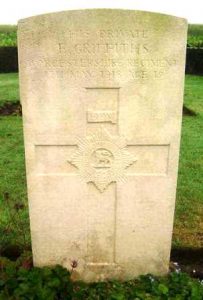
David John Hughes, Private, 13926, King’s Shropshire Light Infantry. David was the son of Owen and Annie Morris Hughes, of Cader View, Tywyn. He married Maggie Williams, of 1, Bodfor Terrace, Aberdovey in 1915, just after having enlisted at Swansea into the King’s Shropshire Light Infantry. David was posted to the 8th Battalion, KSLI, which was attached to 66 Brigade, 22nd Division. On 5 September 1915 David landed in France with the battalion, but his stay in France was short lived, as the 22nd Division was transferred to the Salonika front and entrained for Marseilles before sailing for Salonika on 28 October 1915. The Division took part in the Retreat from Serbia during December 1915, following the defeat of the Serb army by the Bulgarians. Between 10 to 18 August 1916 the Division fought at the battle of Horseshoe Hill, then between 13 to 14 September 1916 at the battle of Machukovo. David was killed in action on 22 April 1917, aged 31. He is buried in Karasouli Military Cemetery, Salonika.
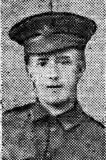
John Price Hughes, Lance Corporal, 2517, Royal Welsh Fusiliers. John was born in America in 1889, the son of David and Anne Hughes. By 1901 the family had moved back to Wales, and lived at Utica House, Tanygrisiau, Blaenau Festiniog. By 1911 John was living at 20, Bron Mierion, National Street, Tywyn, where he worked as a Printer. He married Mary Elizabeth Griffiths, of Tywyn, early in 1915, after having enlisted into the 7th Battalion, Royal Welsh Fusiliers. The battalion was a Territorial unit, which mobilised for war at Newtown in August 1914, as part of North Wales Brigade, Welsh Division and moved to Conway until the end of the month, before moving to Northampton. In December the Division moved to Cambridge and then in May 1915 to Bedford, where the Division was numbered and the formation became 158 Brigade, 53rd (Welsh) Division. On 19 July 1915 the entire Division sailed from Devonport for Imbros and on 9 August 1915 landed at Suvla Bay. The infantry moved off the beaches into the bush, but due to a lack of maps and no knowledge of the terrain, many of the units became disorientated, and the situation became chaotic. John was killed in action at Gallipoli on the following day, 10 August 1915, aged 26. He is buried in Green Hill Cemetery, Gallipoli.
Richard William James, MiD, Corporal, 443506, Canadian Infantry. Richard was born on 5 September 1884, the son of Morris and Margaret James, of Tywyn. He had moved to the South Wales valleys as a young man, and had served for two years with the 5th Battalion, South Wales Borderers (Militia), before emigrating to Canada. Richard found work as a miner before enlisting into the 54th Battalion, Canadian Infantry at Vernon, British Columbia on 18 May 1915. Richard embarked for Britain with the Battalion on 22 November 1915 and disembarked in France on 14 August 1916. The Battalion was attached to the 11th Infantry Brigade, 4th Canadian Division, and moved to the Somme, to take part in the Somme offensive, and saw heavy fighting at Le Transloy and during the capture of Regina Trench, during the Battle of the Ancre. On 9 April 1917 the Division took part in the assault on Vimy Ridge, and took part in further fighting around Souchez and the capture of the village of Avion. The Canadians then moved to the Ypres Salient, and took part in the fighting to capture Passchendaele Ridge, towards the end of the Third Battle of Ypres. Richard was Mentioned in Despatches for Third Ypres, and his mention was published in the London Gazette of 28 December 1917. The Canadians then moved to the southern Somme sector, and on 8 August 1918 took part in the famous success at Villers-Bretonneux alongside the Australians, which was the turning point of the war. From 21 August 1918 the Allies took the offensive, and began to push towards the Hindenburg Line. Richard was badly wounded when his battalion was moving into assembly positions in readiness for a frontal assault on Bourlon Wood. He died of his wounds on 27 September 1918, aged 35, and is buried in Triangle Cemetery, Inchy-en-Artois, France.
Isaac Lewis Jenkins, Drummer, 16425, Welsh Regiment. Isaac was born at Tywyn on 10 June 1891, the son of Evan and Sarah Jenkins. The family later moved to 12, St. David Street, Llanelli, and Isaac met and married Kate E. Griffiths at Llanelli in June 1911. The couple then moved back to North Wales, and lived at 6, Union Square, Dolgellau. Isaac enlisted soon after the outbreak of war into the 10th Battalion, Welsh Regiment. The battalion was raised in the Rhondda Valley by D. Watts Morgan, M.P. in September 1914, originally moving to Codford St. Mary to join 76 Brigade, 25th Division. At the end of September, it was sent to North Wales to join the other locally raised units in 129 Brigade, 43rd (Welsh) Division at Rhyl. On 29 April 1915 the formation was renumbered 114 Brigade, 38th (Welsh) Division, moving to Winchester to complete its training. The Division moved to France on 2 December 1915 and moved to the Nursery Sector near Fleurbaix for trench initiation alongside the Guards Division. The Division then held a sector of the line near Cuinchy before marching south to the Somme sector in June 1916 to take part in the assault on Mametz Wood. The first attack on the wood was launched on a two-battalion front on 7 July, but failed, and the Divisional Commander, Sir Ivor Philipps, was replaced before the Division attacked again on a two Brigade front on 10 July 1916. Isaac was killed during the latter stages of the capture of the wood, on 12 July 1916. The 27-year-old has no known grave, and is commemorated on the Thiepval Memorial, France.
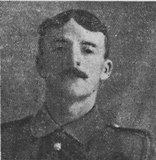
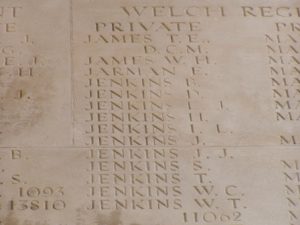
David Jones, Private, 2820, Welsh Guards. David was the son of David and Anne Jones, of Plascoch, Rhydyronen, Tywyn. He enlisted at Dolgellau into the Welsh Guards. The Regiment was raised by Royal Warrant of 26 February 1915, at White City, before landing at Le Havre on 18 August 1915, becoming attached to 3rd Guards Brigade, Guards Division. The Division saw its first major action during the Battle of Loos, which began on 25 September 1915, remaining in the area during the coming months, where they also fought in the subsequent Action of Hohenzollern Redoubt. In July 1916 the Division moved to the Somme, where they fought at the Battle of Flers-Courcelette, and then at the Battle of Morval, capturing Lesboeufs Village. The Division remained here for the winter, and in March 1917 took part in the advance caused by the German Retreat to the Hindenburg Line. Later that year the Division moved north to Ypres and fought at the Battle of the Pilckem Ridge. The Guards saw further fighting at Passchendaele before the Division was moved south to take part in the Battle of Cambrai. The Guards saw heavy fighting following the German counter-attack before the battle closed down, and remained in the area over the final winter of the war. The Guards Division was stationed near Gouzeaucourt when the German Spring Offensive hit the area on 21 March 1918, and saw heavy fighting during the withdrawal that followed. After a period out of the line rebuilding and training before moving back into the line at Boyelles on 7 August 1918. David was killed whilst the Welsh Guards were holding the line at Boyelles on 20 July 1918. The 25-year-old is buried in Berles New Military Cemetery, France.

Evan Lewis Jones, Company Quartermaster Sergeant, 2034, Royal Welsh Fusiliers. Evan was the son of Rees and Anne Jones, of Tywyn. He married Sarah Mary Morgan in 1903, and the couple lived at 7, High Street, Tywyn. Evan was a long serving Territorial soldier, who had enlisted in 1897 and had served in the Boer War of 1899-1902. By the time war erupted in August 1914, Evan was serving as Company Quartermaster Sergeant with the 7th Battalion, Royal Welsh Fusiliers. The battalion was a Territorial unit, which mobilised for war at Newtown in August 1914, as part of North Wales Brigade, Welsh Division and moved to Conway until the end of the month, before moving to Northampton. In December the Division moved to Cambridge and then in May 1915 to Bedford, where the Division was numbered and the formation became 158 Brigade, 53rd (Welsh) Division. On 19 July 1915 the entire Division sailed from Devonport for Imbros and on 9 August 1915 landed at Suvla Bay. The infantry moved off the beaches into the bush, but due to a lack of maps and no knowledge of the terrain, many of the units became disorientated, and the situation became chaotic. Evan was badly wounded during the landings and was evacuated aboard a Hospital Ship where he died of his wounds two days later, on 11 August 1915, aged 37. He was buried at sea, so is commemorated on the Helles Memorial, Gallipoli.
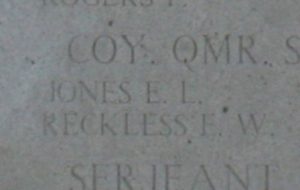
John David Jones, Private, 2218305, Canadian Infantry. John was born on 12 April 1886, the son of David and Catherine Jones, of Brig-y-Don, High Street, Tywyn. He emigrated to Canada prior to the war, and worked as a Salesman at Vancouver. John enlisted at Vancouver into the 196th Overseas Battalion, Canadian Infantry on 3 April 1917. He arrived in England aboard the SS Missanabie on 23 August 1917, and joined the 1st Reserve Battalion at Salisbury Plain. On 10 April 1918 John was posted to France, joining the 7th Battalion, Canadian Infantry, which was attached to the 2nd Brigade, 1st Canadian Division in the Arras Sector, and joined the battalion on 12 April when it was in billets in Arras. In June the Canadians began to move out of the front area, prior to a move south to the southern Somme sector in the first week of August. On 8 August the Canadians took part in a combined assault with the Australians, which broke the Germans at Villers-Bretonneux. This was to become known as ‘The Black Day of the German Army’, a defeat which proved the turning point of the war. On 21 August 1918 the Allies launched an offensive along the Western Front, towards the Hindenburg Line, and the Canadians moved back to the Arras sector to take up the offensive from there towards Cambrai. On 1 September the 7th Battalion, CEF moved into the front line, taking over Unicorn and Union Trenches, and at 5.00 the following morning, 2 September 1918, launched an assault, behind a creeping artillery barrage, against the German lines. The battalion inflicted severe casualties upon the Germans, but had suffered over 120 casualties themselves. John was among over 20 men of the battalion killed during the days fighting. The 32-year-old is buried in Upton Wood Cemetery, Hendecourt-Les-Cagnicourt, France. He is also commemorated on a memorial tablet within Tallyllyn Parish Church.
John Morris Jones, Private, 35431, King’s Shropshire Light Infantry. John was the son of John and Elizabeth Jones, of 3, Wesleyan Terrace, Tywyn. He enlisted at Tywyn into the army, and after completing his training was posted to the 6th Battalion, King’s Shropshire Light Infantry. The battalion had been in France since 22 July 1915, attached to 60 Brigade, 20th (Light) Division. John would have joined the battalion at Ypres late in 1917, where the battalion was rebuilding as a result of heavy losses suffered during the Battle of Cambrai. On 27 December the battalion entrained for Ebblinghem, and marched to billets at Wardrescques. On 7 January 1918 the 6th KSLI went back into the front line at Ypres, taking over positions at Torr Top Tunnels and then in the front line near Gheluvelt. After six weeks here, the Division began to move away from the Ypres Salient again, and moved to the southern edge of the British Sector at Libermont, before taking over a sector of line near Cugny, to the north-east of Noyon. On 20 March 1918 the battalion was ordered to ‘Man Battle Stations’ after receiving news of a potential German attack. Nothing happened that day, but at dawn the following morning, the same orders were received, after the front line was hit hard by the Germans, and the 20th Division moved into the battle area, with the 6th KSLI moving into reserve positions in quarries at Bray St. Christopher. By now the Germans had broken through on a wide front, from Cambrai to La Fère, and on 22 March the 20th Division came into action. Desperate fighting raged over the coming days, as the Division was forced to withdraw, and the 6th KSLI suffered terrible casualties. John was taken prisoner by the Germans during the day, and was eventually moved to a POW Camp at Giessen, in Hessen. He suffered in captivity and died of internal complications at Giessen on 28 April 1918, aged 19. John is buried in Niederzwehren Cemetery, Kassel, Germany.
Robert Jones, Lance Corporal, 15160, Royal Welsh Fusiliers. Robert was born on 1 October 1890, the son of Robert Jones and Mary Susan Jones (nee Thomas), of 8, Frankwell Street, Tywyn. He worked as a Teamster prior to enlisting into the 10th Battalion, Royal Welsh Fusiliers on 11 September 1914. The battalion was formed at Wrexham, before moving to Codford St. Mary, joining 76 Brigade, 25th Division. The Division landed at Boulogne on 27 September 1915, and moved to the southern sector of the Ypres Salient. Although a relatively peaceful period, the 10th RWF began suffering a steady string of casualties during its periods holding the front line over the coming weeks, whilst acclimatising to front line life. Robert served with A Company of the 10th RWF, and was wounded whilst in the line on 4 January 1916. He was brought back to the massive casualty clearing station at Remy Sidings, where he died of his wounds two days later, on 6 January 1916, aged 26. He is buried in Lijssenthoek Military Cemetery, Belgium.

William Robert Jones, Private, 291187, Royal Welsh Fusiliers. William was the son of John and Margaret Jones, of 7, Red Lion Street, Tywyn. He enlisted at Tywyn into the 7th Battalion, Royal Welsh Fusiliers, which was the local Territorial unit, and was posted to Park Hall Camp, Oswestry, to join the 3/7th Battalion, Royal Welsh Fusiliers. On 24 May 1917 William landed in France, joining No 5 Infantry Base Depot, and from there was posted to the 14th Battalion, Royal Welsh Fusiliers on 12 June 1917. The battalion was at Ypres, attached to 113 Brigade, 38th (Welsh) Division, which was holding the Canal Bank sector at Boesinghe, north of Ypres. The Division was at that time training and preparing to launch an assault on the German held Pilckem Ridge, as part of the opening assault of the Third Battle of Ypres, and on 31 July 1917 launched their attack, capturing the Pilckem Ridge and advancing as far as the Steenbeek, near Langemarck. On 4 August the 14th RWF was relieved and moved back to rest at Elverdinghe Chateau and enjoyed three weeks rest before moving into the front line at Candle Trench on 22 August 1917. The Battle of Langemarck was now raging. On 31 August 1917 the 14th RWF was in the front line, digging forwards towards Langemarck. The war diary for the day notes that the line was quiet, but William was killed by a sniper during the day. The 19-year-old has no known grave and is commemorated on the Tyne Cot Memorial, Belgium.
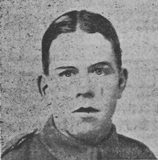
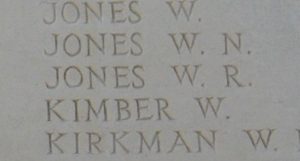
Frederick Morris, Private, 2513, Royal Welsh Fusiliers. Frederick was the son of John and Malinda Morris, of Pentrepoeth, Tywyn. He enlisted at Tywyn into the 7th Battalion, Royal Welsh Fusiliers soon after the outbreak of war. The battalion was a Territorial unit, which mobilised for war at Newtown in August 1914, as part of North Wales Brigade, Welsh Division and moved to Conway until the end of the month, before moving to Northampton. In December the Division moved to Cambridge and then in May 1915 to Bedford, where the Division was numbered and the formation became 158 Brigade, 53rd (Welsh) Division. On 19 July 1915 the entire Division sailed from Devonport for Imbros and on 9 August 1915 landed at Suvla Bay. The infantry moved off the beaches into the bush, but due to a lack of maps and no knowledge of the terrain, many of the units became disorientated, and the situation became chaotic. The Division remained on the Gallipoli peninsula over the coming months and by the beginning of December began to prepare for evacuation from Gallipoli. Frederick was unfortunately wounded by Turkish artillery fire just prior to the evacuation, and was taken aboard the Hospital Ship Assaye, where he died of his wounds on 11 December 1915, aged 19. He was buried at sea, so is commemorated on the Helles Memorial, Gallipoli. His brother John was killed the following year.
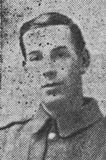
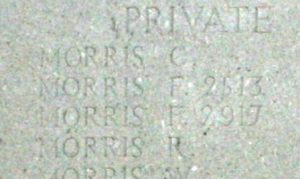
John Morris, Private, 25557, Royal Welsh Fusiliers. John was the son of John and Malinda Morris, of Pentrepoeth, Tywyn. He married Hannah Williams at Llanymynech Church on 15 May 1906, and the couple set up home at 49, Frankwell Street, Tywyn. John worked as a Joiner prior to the war, and had served with the 5th Battalion, South Wales Borderers and the 7th Battalion, Royal Welsh Fusiliers, both Volunteer units. Following the outbreak of war, he enlisted at Tywyn into the 17th Battalion, Royal Welsh Fusiliers on 6 March 1915. The battalion had been raised at Llandudno as part of 128 Brigade, 43rd (Welsh) Division and trained in North Wales before moving to Winchester in the summer of 1915, where the formation became renumbered 113 Brigade, 38th (Welsh) Division. The Division moved to France on 2 December 1915 and moved to the Nursery Sector near Fleurbaix for trench initiation alongside the Guards Division. The Division then held a sector of the line near Cuinchy before marching south to the Somme sector in June 1916 to take part in the assault on Mametz Wood. The first attack on the wood was launched on a two-battalion front on 7 July, but failed, and the Divisional Commander, Sir Ivor Philipps, was replaced before the Division attacked again on a two Brigade front on 10 July 1916. The fighting in the wood was horrific, and lasted over two days before the survivors were relieved. John was recorded as missing, presumed killed in action, at some time between 10 and 12 July 1916, and was later deemed to have been killed in action on 12 July 1916. The 36-year-old has no known grave, and is commemorated on the Thiepval Memorial, France.
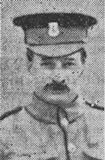
Evan Griffith Owen, Private, 20738, Royal Welsh Fusiliers. Evan was the son of Evan and Mary Owen, of Fronheulog, Tywyn. He worked on his father’s farm prior to enlisting at Tywyn into the 14th Battalion, Royal Welsh Fusiliers soon after the outbreak of war. The battalion was raised at Llandudno by the Welsh National Executive Committee, joining 128 Brigade, 43rd (Welsh) Division and trained in North Wales before moving to Winchester in the summer of 1915, where the formation became renumbered 113 Brigade, 38th (Welsh) Division. The Division moved to France on 2 December 1915 and moved to the Nursery Sector near Fleurbaix for trench initiation alongside the Guards Division. The Division then held a sector of the line near Cuinchy before marching south to the Somme sector in June 1916 to take part in the assault on Mametz Wood. Just prior to the move south, Evan’s battalion was holding the line at Winchester Post, and carried out a well-planned operation against the Germans opposite them, following up an artillery barrage which had opened a gap in the German wire with a trench raid. The raiders entered and bombed the German trenches before returning back to their own lines in small groups. Several similar operations were carried out over the coming days, before the battalion was relieved on 8 June, and it was during one of these raids that Evan was wounded. He was evacuated to the Hospital at Aubigny, where he died of his wounds on 23 June 1916, aged 22. Evan is buried in Aubigny Communal Cemetery Extension, France.
John Pugh Owens, Private, 37435, Machine Gun Corps. John was born in Berriew in 1896, the son of Thomas and Edith Harriet Owens. By 1901 the family had moved to Brynymor, Tywyn. John enlisted at Tywyn into the 7th Battalion, Royal Welsh Fusiliers early in the war. He was posted to Park Hall, Oswestry for training, and after completing his training was posted to France, joining the 49th Company, Machine Gun Corps, which was attached to the 16th (Irish) Division. During December 1915 the Division moved to France and concentrated in the Bethune area. It saw its first major action during the Somme Offensive, at the Battle of Guillemont, and also fought at the Battle of Ginchy. By May 1917 the Division had moved to positions south of Ypres, taking part in the Battle of Messines, and then moved north, fighting at the Battle of Langemarck. The Division then moved to the Villers-Faucon sector over the winter, facing the Hindenburg Line. John’s Company was in the line near St. Emelie on 24 February 1918, firing a machine-gun barrage on the German strongpoint of Quennemont Farm, when John was killed, possibly by German artillery fire, which was very active during the day. The 21-year-old is buried in Villers-Faucon Communal Cemetery Extension, France.
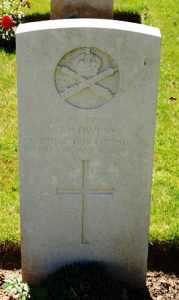
Walter Edward Pugh, Private, 277437, Manchester Regiment. Walter was born at Wallingford, Berkshire in 1898, the son of George and Sarah Pugh. The family later moved to Penmaenmawr by 1911 and then to The Cottage, Pemarthuchaf, Tywyn. Walter enlisted into the Royal Welsh Fusiliers, but upon completing his training, was posted to the 2/7th Battalion, Manchester Regiment, which was attached to 199 Brigade, 66th Division. He landed in Boulogne, France with the battalion on 7 March 1917, and the entire Division then concentrated around the area of Aire-sur-la-Lys, before heading to Cambrin. On 19 March 1917 Walter’s battalion moved into the front line for the first time, taking over a section of line on the left of the Cambrin sector. On 21 March 1917, on his third day in the trenches, Walter was killed when a German trench mortar shell hit a dugout he was sharing with some other men. He was 19 years old and is buried in Dud Corner Cemetery, Loos, France.
William Pugh, Private, 290540, Royal Welsh Fusiliers. William was the son of Arthur and Anne Pugh, of Rhydyronen, Tywyn. He worked as a labourer prior to enlisting at Tywyn into the 7th Battalion, Royal Welsh Fusiliers on 7 August 1914. The battalion was a Territorial unit, which mobilised for war at Newtown in August 1914, as part of North Wales Brigade, Welsh Division and moved to Conway until the end of the month, before moving to Northampton. In December the Division moved to Cambridge and then in May 1915 to Bedford, where the Division was numbered and the formation became 158 Brigade, 53rd (Welsh) Division. William remained behind in Bedford, attached to the 2/7th Battalion, Royal Welsh Fusiliers, the reserve unit, so he missed the terrible ordeal the Division suffered when it landed at Suvla Bay, Gallipoli on 9 August 1915. The Division was eventually evacuated from Gallipoli in December 1915, moving to Egypt to join the EEF, and helped guard the Suez Canal before taking part in operations to drive the Turks out of the Sinai. William was posted out to Egypt to join the 1/7th Battalion, Royal Welsh Fusiliers on 27 January 1916. The EEF then turned its attention onto driving the Turks out of Palestine, and on 26 March 1917 launched its first offensive against the coastal city of Gaza, which guarded the road to Jerusalem. Initial gains during the day were lost when the assaulting divisions lost touch with each other and communication broke down when a thick fog cloaked the battlefield, and the battle was lost, so a second attempt to force Gaza was launched on 17 April, which again failed. William was wounded in the leg in the period after the Second Battle of Gaza, and was treated at the 17th General Hospital at Alexandria. He returned to duty once he had recovered and survived the war, being demobilised on 8 April 1919 and returning home. His health then started to decline, and William died of tuberculosis on 18 March 1920, aged 23. He is buried in Tywyn Cemetery. William is not commemorated on the Tywyn memorial, probably as he died after it was erected.
John Rees, Corporal, 11454, Grenadier Guards. John was the son of David and Ann Rees, of Reform Cottage, Bryncrug, Tywyn. He had served during the Boer War of 1899-1902 prior to moving to Llandybie to work for the Post Office as a letter carrier. John re-enlisted at Aberystwyth soon after the outbreak of war into the 2nd Battalion, Grenadier Guards. He joined the battalion in France on 30 September 1914. The battalion was attached to the 4th (Guards) Brigade, 2nd Division, and had been among the first units in France, fighting at the Battle of Mons, and retreating southwards, where the Division took part in the Affair of Landrecies, the Rearguard Actions of Villers-Cotterets, and at the Battle of the Marne where the German offensive was stopped. The BEF then moved north to guard the Channel ports, and took up defensive positions east of Ypres. The 2nd Division then fought at the First Battle of Ypres, where the German sweep through Flanders was stopped, and remained there throughout the first winter of the war. The conditions were terrible, and John was hospitalised in February 1915 after falling ill. Upon his recovery, he was posted to the 1st Battalion, Grenadier Guards on 7 March 1915. The battalion was at Neuve Chapelle, attached to 20 Brigade, 7th Division, and was preparing for an offensive. On 10 March 1915 the 1st Grenadiers took part in the Battle of Neuve Chapelle, which had been launched in conjunction with a French assault on Vimy Ridge. The battle proved a disaster for the Allies, with no real gains, despite suffering heavy casualties. John was killed in action at sometime between 10 to 14 March 1915. The 32-year-old has no known grave and is commemorated on the Le Touret Memorial, Richebourg L’Avoue, France. He is also commemorated on the Llanegryn and the Llandybie memorials.
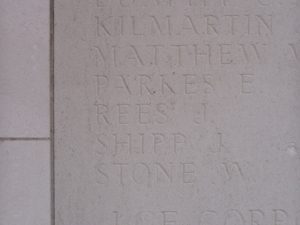
Griffith Evans Roberts, Second Lieutenant, Border Regiment. Griffith was born on 17 April 1891, the son of William Roberts, Headmaster of Bryncryg School, and Margaret Jane Roberts, of Bryn Rodyn, Tywyn. He was educated at the County School, and in January 1909 began work for the National Provincial Bank of England at its Manchester branch. In January 1912 he was promoted to clerk, and later that year he transferred to the staff of Cardiff Bute Docks branch, working at its sub-branch at Abertillery. He left his role to enlist into the army and was commissioned into the Border Regiment on 5 September 1916. Griffith was posted to the 6th Battalion, Border Regiment. The battalion had taken part in the Gallipoli campaign attached to 33 Brigade, 11th (Northern) Division, then spent six months in Egypt before moving to France on 6 July 1916. Griffith joined the battalion on the Somme, where the Division took part in the Battle of Flers-Courcelette during the Somme Offensive. The Division spent the winter on the Ancre, before moving north to the Messines sector. In June 1917 the Division took part in the Battle of Messines ridge. The battle was launched with the blowing of nineteen massive underground mines, which devastated the German front line, then the infantry attacked, supported by large numbers of tanks. The 33 Brigade was held up on its way to the assembly area, causing issues for the neighbouring 19th Division, as 33 Brigade attacked Vandamme Farm 30 minutes behind schedule. Griffith was killed in action during the assault that morning. The 26-year-old has no known grave, and is commemorated on the Ypres (Menin Gate) Memorial, Belgium. His sister, Jane, had been killed just two months previously, and his father had died on 23 May after receiving news of her death.
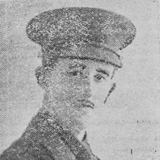
Jane Roberts, Staff Nurse, Queen Alexandra’s Imperial Military Nursing Service. Jane, known as Jenny to her family, was the daughter of William and Margaret Jane Roberts, of Bryn Rodyn, Tywyn. She trained as a Nurse at St. James’, Wandsworth and at Middlesex Hospital, before gaining a position at the Princess Christian Nursing Home at Windsor. Jane volunteered to serve with Queen Alexandra’s Imperial Military Nursing Service following the outbreak of war and served at Birmingham Hospital before embarking for Egypt, to serve at the 19th General Hospital, Alexandria, where she treated men who had been wounded at Gallipoli. In June 1916 she was posted aboard the Hospital Ship HMHS Salta, which was a floating hospital, used to collect and transport wounded or sick men. She was a French liner which had been chartered by the Admiralty in February 1915 and converted into a hospital ship, painted white with wide green stripes and the insignia of the Red Cross. On 10 April 1917, Salta was returning to pick up wounded from the port of Le Havre, and was nearing the port when she struck a German laid mine, which blew a large hole in her stern. The stricken ship sank within ten minutes, and of the 205 passengers and crew members aboard, nine nurses, 42 member of the Royal Army Medical Corps (RAMC) and 79 crew drowned. Jane was sadly among the dead. The 27-year-old is commemorated on the HMHS Salta Memorial in Ste. Marie Cemetery, Le Havre, France. Her father died on 23 May after hearing of her death, while her brother Griffith was killed just two months later.
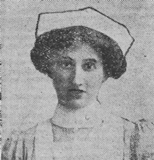
Robert Alfred Roberts, Sergeant, 10076, Somerset Light Infantry. Robert was the son of William Owen Roberts and Elizabeth Roberts, of California Temperance Hotel, High Street, Tywyn. He lived at 37, Rowden Place, Cardiff prior to the war, where he worked as a shop assistant. Robert enlisted at Bath soon after the outbreak of war, and was posted to the 6th Battalion, Somerset Light Infantry. The battalion was formed at Taunton, moving to Aldershot to join 43 Brigade, 14th (Light) Division. After completing its training, the battalion landed at Boulogne on 21 May 1915, before the Division moved to the Ypres Salient, taking up positions at the Scherpenberg. After a brief period acclimatising to trench life, the Division moved to Ypres, marching through the Menin Gate to take up positions on the Menin Road near Railway Wood. The Division was to see its first action during the Action of Hooge on 2 June, where it became the first troops to be attacked by the German use of flamethrowers, in a horrific battle. The Division then fought at the Second attack on Bellewaarde Farm, on 25 September, when the Division launched an assault along the Menin Road against the line stretching from Railway Wood to Sanctuary Wood, with the objective of capturing Bellewaarde Farm. The Division remained here over the coming months before moving south in July 1916, to take part in the great Somme offensive. The Division saw its first major action on the Somme during the Battle of Delville Wood, and once the wood had been cleared, a week of severe fighting which involved several Divisions, the British launched an assault against Flers-Courcelette, using tanks for the first time, on 15 September 1916. The 14th Division attacked a small salient east of Delville Wood on 16 September 1916, but the artillery barrage was poor and the infantry made no gains, suffering heavy casualties from German machine-gun fire. Robert was killed in action at some time during the day. The 30-year-old has no known grave and is commemorated on the Thiepval Memorial, France.

John Rowlands, Lance Corporal, 3462, Royal Welsh Fusiliers. John was the son of John Rowlands and Jane Ellen Rowlands (nee Davies), of Tywyn. He worked as an engine driver prior to the war, and married Jane Elizabeth Hilditch, of Penycae, Shropshire, on 17 November 1909. John enlisted at Tywyn into the 7th Battalion, Royal Welsh Fusiliers soon after the outbreak of war. The battalion was a Territorial unit, which mobilised for war at Newtown in August 1914, as part of North Wales Brigade, Welsh Division and moved to Conway until the end of the month, before moving to Northampton. In December the Division moved to Cambridge and then in May 1915 to Bedford, where the Division was numbered and the formation became 158 Brigade, 53rd (Welsh) Division. On 19 July 1915 the entire Division sailed from Devonport for Imbros and on 9 August 1915 landed at Suvla Bay. The infantry moved off the beaches into the bush, but due to a lack of maps and no knowledge of the terrain, many of the units became disorientated, and the situation became chaotic and many men were killed or wounded over the coming days. John must have been wounded during these early days on Gallipoli and evacuated aboard the Hospital Ship Minnetonka. He was aboard the ship, in Lemnos Harbour, when he was killed in an accident on 6 September 1915, aged 26. John is buried in East Mudros Military Cemetery, Greece.
Arthur Owen Williams, Corporal, 4877, London Regiment. Arthur was born in Brecon in 1894, the son of Reverend Owen Williams and Jane Williams. By 1901 the family was living at Brynawel, Pennal, then by 1911 had moved to Hafod, Tywyn. Arthur became a banker after leaving school, and worked in London. He enlisted in London into the London Regiment soon after the outbreak of war and was posted to the 1/14th Battalion, London Regiment (London Scottish). The battalion had been in France since 16 September 1914, and had taken part in fighting at Messines and Ypres, attached to the Cavalry Corps early in the war before transferring to the 1st Division and took part in the Battle of Loos on 25 September. On 8 February 1916 the battalion joined 168 Brigade, 56th (London) Division, which was forming in the Hallencourt area. Arthur arrived in France on 13 March 1916, joining the battalion on the Somme. The Division was in the northern part of the Somme sector, and on 1 July 1916, the opening day of the Somme offensive, took part in the diversionary attack on Gommecourt. The next major action for the Division was the Battle of Ginchy. On 9 September the Division moved into position under heavy shellfire, and on the following morning, 10 September 1916, launched their attack on the village of Ginchy. Arthur was killed in action that morning, near Bouleaux Wood. The 21-year-old has no known grave and is commemorated on the Thiepval Memorial, France.
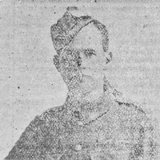
Ellis Ivor Williams, Lance Corporal, 32794, King’s Own (Royal Lancaster Regiment). Ellis was born in Salford in 1894, the son of Llewellyn Williams and Elizabeth Williams (nee Davies). Following the death of his father in 1898, his mother moved the family to her parents home, at Railway Crossing Cottage, Tywyn. Ellis gained work as a Railway Clerk when he left school, first at Newtown, then at Swansea. He enlisted at Swansea into the army, and upon completing his training, was posted to France, joining the 1st Battalion, King’s Own (Royal Lancaster Regiment). The battalion had been in France since 23 August 1914, attached to 12 Brigade, 4th Division and had taken part in the Battle of Le Cateau and the retreat to the Marne, before moving to Ypres, taking part in the Battle of Messines. Ellis probably embarked for France in 1916 to join the battalion on the Somme, where the Division fought at the Battle of Albert and the Battle of Le Transloy. By April 1917 the Division had moved to the Arras sector, and fought at the First Battle of the Scarpe in April, and the Third Battle of the Scarpe, in May 1917. The Battle of Arras then came to a close, as Allied attention moved further north, to the Ypres Salient, and the Arras sector quietened down somewhat. On 6 July 1917, the 1st Battalion, King’s Own was holding the line forward of Arras. Ellis was in a dugout with several other men when a German artillery shell crashed into it, killing William instantly. He was buried by the regimental Chaplain some 300 yards behind the line in a small valley, but unfortunately his grave was lost as a result of further fighting in the area in 1918, and as a result the 22-year-old is commemorated on the Arras Memorial, France.
John Henry Williams, Private, 5651, Royal Welsh Fusiliers. John was the son of Rowland and Catherine Williams, of Tywyn. He married Emily Clark in 1915 and the couple had one child, a son, Rowland Henry Williams, born in 1918. John worked as a Milk Carrier at Aberdyfi prior to the war. He enlisted at Wrexham into the 2/6th Battalion, Royal Welsh Fusiliers on 24 October 1916, but whilst training was found to be unfit for overseas service, and was transferred to the 430th Agricultural Company, Labour Corps, in Norfolk. John was based in Norfolk for almost two years, but a month before the end of the war contracted influenza, and died at Norwich Military Hospital on 24 October 1918, aged 28. His remains were conveyed home for burial in Tywyn Cemetery. John is not commemorated on the Tywyn memorial.
Robert Williams, Sergeant, 290539, Royal Welsh Fusiliers. Robert was the son of David and Mary Ann Williams, of Talgarth Cottage, Pennal. He worked as a grocer at Porth Gwyn Stores prior to enlisting into the 7th Battalion, Royal Welsh Fusiliers at Tywyn on 7 August 1914. The battalion was a Territorial unit, which mobilised for war at Newtown in August 1914, as part of North Wales Brigade, Welsh Division and moved to Conway until the end of the month, before moving to Northampton. In December the Division moved to Cambridge and then in May 1915 to Bedford, where the Division was numbered and the formation became 158 Brigade, 53rd (Welsh) Division. On 19 July 1915 the entire Division sailed from Devonport for Imbros and on 9 August 1915 landed at Suvla Bay. The Division was eventually evacuated from Gallipoli in December 1915, moving to Egypt to join the EEF, and helped guard the Suez Canal before taking part in operations to drive the Turks out of the Sinai. The EEF then turned its attention onto driving the Turks out of Palestine, and on 26 March 1917 launched its first offensive against the coastal city of Gaza, which guarded the road to Jerusalem. Initial gains during the day were lost when the assaulting divisions lost touch with each other and communication broke down when a thick fog cloaked the battlefield. Robert was killed at some time during the days fighting. The 21-year-old has no known grave and is commemorated on the Jerusalem Memorial, Israel. He is also commemorated on the Pennal War Memorial. (The CWGC records that Robert was killed on 26 February 1917, but this is an error).
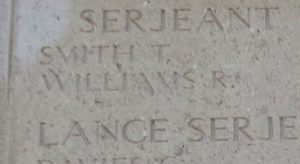
William Edward Williams, Rifleman, R/29414, King’s Royal Rifle Corps. William was the son of Hugh and Catherine Williams, of 20, Bronmeirion, National Street, Tywyn. He worked in London prior to the war and enlisted in Hackney into the King’s Royal Rifle Corps. After he had completed his training, William was posted to France in 1916, joining the 7th Battalion, King’s Royal Rifle Corps, which was attached to 43 Brigade, 14th (Light) Division. He probably took part in the Divisions actions on the Somme that year, during the Battle of Delville Wood, and then the Battle of Flers-Courcelette. During March 1917 the Division followed the German Retreat to the Hindenburg Line. May saw the Division at Arras, where it took part in the First Battle of the Scarpe, and later at the Third Battle of the Scarpe, before the Division was transferred to the Ypres Salient in July. The Division then took over trenches near Zillebeke, near to where it had fought when first arriving at the front three years earlier. The Division saw heavy fighting at Dickebusch in August 1917, before spending most of September training at Neuve Eglise. On 10 October 1917 the 7th KRRC moved back into the front-line trenches at Dickebusch, to begin an unpleasant six day spell holding the line, suffering heavy shell-fire almost without respite. William was killed in action here on 11 October 1917, aged 28. He has no known grave and is commemorated on the Tyne Cot Memorial, Belgium.
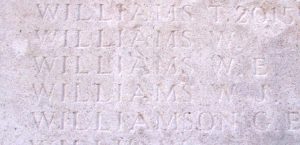
World War Two, 1939 -1945
Thomas William Challoner, DFC, Pilot Officer, 50465, Royal Air Force. Thomas was the son of Thomas Challoner and Lucy May Challoner (nee Jones), of Arwelfa, Brynmair Terrace, Tywyn. He enlisted into the Royal Air Force and trained as a pilot. Thomas married Joyce Eveline Martin, of Enderby, Leicestershire, whilst based nearby in 1941. He was then posted to 161 Squadron, RAF, which was based at RAF Tempsford, a Royal Air Force Special Duty Service Airfield. The squadron was a Special Duties Squadron, equipped with various aircraft, such as Lysanders, Whitley’s, Wellington’s and the Avro Halifax, and carried out secret missions in support of the Special Operations Executive and the Secret Intelligence Service. On the night of 19 March 1943, Thomas took off from Enderby aboard Halifax V, serial DG244, on an SOE mission to supply operators in Norway. The operation was codenamed Operation SSI Vega. The aircraft was lost soon afterwards, probably after being intercepted and shot down in the Skaggerad, off Norway. Thomas has no known grave and is commemorated on the Runnymede Memorial, Surrey, alongside his fellow crewmen. He had been awarded the Distinguished Flying Cross during the war.
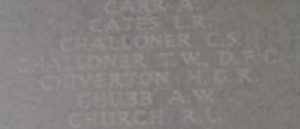
Claude Mehew Davies, MRCS, LRCP, Surgeon Lieutenant, Royal Naval Volunteer Reserve. Claude was born on 18 February 1913. He appears to have been an orphan, who was adopted from the London Workhouse at Southwark in 1916, probably by John Robert Owen and Rachel Owen, of 1, Glandwr, Bryncrug, Tywyn. By 1939 he was a Medical Student, lodging at the Foxhound Inn, Thurrock, and after qualifying on 19 January 1942, enlisted into the Royal Naval Volunteer Reserve, being granted the rank of Surgeon Lieutenant. He was posted to HMS Drake, at Devonport on 6 November, then in January 1943 was posted to HMS Spartiate, the Royal Naval Base in Clyde, Glasgow. Claude was then posted aboard the Steamship SS St Sunniva. She was a passenger ship which had been converted by the Royal Navy for use as a convoy rescue ship, and had a fully equipped hospital for treating rescued sailors. St Sunniva disappeared with all hands, off Sable Island during the early morning of 22 January 1943, whilst taking part in an Atlantic Convoy. She was presumed to have capsized due to heavy ice build-up in her rigging, due to the terrible conditions at the time. Claude was 29 years old when he drowned during the loss of St Sunniva, and he is commemorated on the Portsmouth Naval Memorial, Hampshire. (Claude is named on the memorial as Claude Mehew Owen, probably due to being adopted, but all records point to him living and serving as Davies).
David Lewis Davies, Trooper, 4204126, Reconnaissance Corps. David was born on 22 May 1912, the son of David and Margaret Sarah Davies, of 32, Frankwell Street, Tywyn. He married Catherine Margaretta Evans in 1935, and the couple lived at his parents’ home, where David worked as a Shop Assistant. David enlisted into the army following the outbreak of war, and was posted to the 56th Regiment, Reconnaissance Corps, which was attached to the Royal Armoured Corps. The regiment had been formed in Kent in 1940, and trained with Bren Gun Carriers. The men were hand-picked, highly intelligent, and were well trained. In August 1942 the regiment joined the 78th (Battleaxe) Division in Scotland, before sailing for North Africa to join the 1st Army. The Division took part in Operation Torch and the Tunisian Campaign, helping force the surrender of Rommel’s Afrika Korps in May 1943. The 78th Division was then transferred to the 8th Army, and took part in the invasion of Sicily from July 1943. The Division was then withdrawn to Egypt for a rest, and infamously its men played a leading role in starting the Cairo Riots. The Division then moved to mainland Italy, crossing the Sangro River before taking part in the bloody fighting for Monte Cassino. David was killed at Cassino on 20 March 1944, aged 32. He is buried in Cassino War Cemetery, Italy.
Edward Owen Davies, Private, 4207372, Pioneer Corps. Edward was born on 20 September 1910, the son of Hugh and Mary Davies, of 5, Gwalia Road, Tywyn. He enlisted into the army and was posted to the Pioneer Corps. Edward died in the East Glamorgan registration district on 24 May 1943, aged 32. He is buried in Tywyn Cemetery.
Lewis Davies, Gunner, 1492724, Royal Artillery. Lewis was born on 21 November 1918, the son of Griffith and Mary Davies, of Tywyn. He enlisted into the army and was posted to Singapore to join 9 Coast Regiment, Royal Artillery, which formed part of the defences for the massive British garrison at Singapore. In December 1941 the Japanese launched invasions of Malaya and Thailand from Indochina, and Pearl Harbour was also bombed on 7 December. On 8 February 1942 the Japanese attacked Singapore across the Johor Strait, and heavy fighting raged over the coming days. On 15 February 1942 the British surrendered to the Japanese, an event referred to by Winston Churchill as: “the worst disaster and largest capitulation in British history”. Lewis was among around 80,000 men taken into captivity by the Japanese. After surviving three years in captivity, working on the Thai-Burma Railway, Lewis was attached to No 10 POW Group, comprising of 2,091 POW’s being transported from Thailand 4D Camp to a POW Camp in French Indo China when their train was attacked and bombed by Allied Aircraft on 9 April 1945. He was among a large number of men killed during the attack, whilst many others were badly wounded. Lewis was 26 years old when he died that day and was originally buried in Saigon Military Cemetery. His grave was exhumed, along with all of the other military burials there, and re-interred in Kranji War Cemetery, Singapore in March 1954.
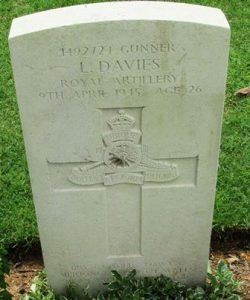
William Thomas Patrick Davies, Flight Sergeant, 552842, Royal Air Force. William was the son of William and Kathleen Davies, of Garage Cottage, Rhowniar, Tywyn.He enlisted into the Royal Air Force, and was posted out to the Far East. William survived the war, and was still in the Far East when the Japanese surrendered. On 7 September 1945 he boarded an RAF Dakota IV, Serial KN584 from 357 Squadron, which had taken off from Rangoon to drop supplies to SOE operatives. The Dakota struck mountains near the village of Mewaing killing all sixteen military personnel aboard her. William was 23 years old when he was killed in the crash. The wreck was found ten days later, and the men were all buried in the Monastery at Mewaing. Due to the remote location of the graves, they are not maintained by the CWGC, so William and the other fifteen men are commemorated on Special Memorials within Taukkyan War Cemetery, Myanmar.
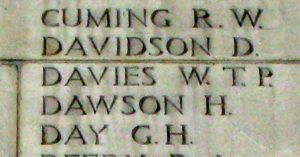
David Alderson Edwards, Sergeant, 2220578, Royal Air Force Volunteer Reserve. David was born on 17 May 1909, the son of Joseph Francis and Lavinia Edwards, of 6, Corbett Square, Tywyn. He enlisted into the Royal Air Force Volunteer Reserve, and was posted to 1667 Heavy Conversion Unit, based at RAF Sandtoft, North Lincolnshire. In the early hours of 19 March 1944 David was flying aboard a Handley Page Halifax, Serial ED149 on a night exercise when it suffered engine problems, and crashed into pylons at Crowle, some nine miles from Scunthorpe, killing David and two other crewmen. David was 34 years old, and his remains were brought home for burial in Tywyn Cemetery.
Idris Meirion Evans, Civilian. Idris was born on 23 September 1934, the son of John Henry Evans and Sarah Catherine Evans (nee Pugh), of 3, Abertrinant Cottages, Tywyn. Idris was playing at Dolaugwyn, Tywyn when he was killed by an unexploded mortar bomb on 7 May 1944. He was just 9 years old. His brother, John Henry Evans, was killed in Germany in 1945. Idris is not commemorated on the Tywyn war memorial.
John Henry Evans, Fusilier, 14759441, Royal Welch Fusiliers. John was the son of John Henry Evans and Sarah Catherine Evans (nee Pugh), of 3, Abertrinant Cottages, Tywyn. He enlisted into the 4th Battalion, Royal Welch Fusiliers, which was attached to 158 Brigade, 53rd (Welsh) Division. The Division spent much of the war on home service, in Northern Ireland and the south of England, before landing in Normandy at the end of June 1944. The Division took part in heavy fighting in the Bocage, before the Allies broke out of the Normandy beach-head, and then took part in the drive through Northern France into Belgium and Holland, towards the German frontier. The Division took in the Battle of the Bulge, helping stop the German offensive in the Ardennes, and in March 1945 took part in Operation Plunder, the Rhine crossings. The Division then took part in the advance across the Ems and Elbe Rivers towards Hamburg. John was killed during a German counter-attack on 14 April 1945, aged 19. He is buried in Becklingen War Cemetery, Germany. His younger brother, Idris, had been killed by a mortar bomb at Tywyn the previous year.
David Richard Griffiths, Fusilier, 4195521, Royal Welch Fusiliers. Very little is currently known of David, but he served with the 7th Battalion, Royal Welsh Fusiliers, which was a Territorial battalion, attached to 158 Brigade, 53rd (Welsh) Division. The Division was mobilised following the outbreak of war, and by the end of October 1939 part of the Division had begun moving to Northern Ireland, whilst the remainder of the Division was in Pembrokeshire. David died on 5 December 1939, and is buried in Tywyn Cemetery.
William John Jarman, Sergeant, 1432745, Royal Air Force Volunteer Reserve. William was born on 24 October 1923, the son of John Thomas Jarman and Elizabeth Jane Jarman, of Liverpool House, Tywyn. He enlisted into the Royal Air Force Volunteer Reserve, and after training as a Wireless Operator, was posted to 630 Squadron, RAF, which was a Bomber Command unit, based at RAF East Kirkby, near Spilsby, Lincolnshire. On the night of 18 July 1944, William took off from East Kirkby aboard Avro Lancaster III, Serial LM537, as part of a force sent to bomb a railway junction in France. On the early hours of 19 July 1944, the Lancaster was spotted by German AA Batteries, and shot down, crashing at Chassericourt, some nine miles from Brienne-le-Chateau, killing William and two other crewmen. William was 20 years old and was buried alongside his comrades in Chassericourt Churchyard, France.
Edward Glyndwr Jones, Private, 4201668, Sherwood Foresters (Notts and Derby Regiment). Edward was born on 18 July 1913, the son of John Owen Jones and Katie Jones, of 21, Frankwell Street, Tywyn. He worked as a Stone Mason prior to the war and married Rhoda Jane Llewellyn, of Tywyn, in 1940. Edward enlisted into the Army and was posted to the 5th Battalion, Sherwood Foresters (Notts and Derby Regiment). The battalion was raised in 1939 when the TA was doubled in size, and was renamed the 5th Battalion after the loss of the 1/5th Battalion in Malaya in February 1942. The 5th Battalion was attached to the 139th Infantry Brigade, 46th Division, and embarked for North Africa in late 1942, to join the 1st Army. The Division took part in the final stages of the Tunisia Campaign. Following the surrender of the Afrika Korps in May 1943, the Division took part in the invasion of Italy, landing at Salerno in September 1943 as part of the US Fifth Army. Following the break-out from Salerno, the Division took part in the breaking of the Volturno Line, before launching an assault on the Gustav Line. Edward was killed at some time between 2 and 7 December 19143, during heavy fighting on the Gustav Line. He was 29 years old, and was buried in Minturno War Cemetery, Italy.
Emyr William Jones, Sapper, 14342693, Royal Engineers. Emyr was born on 18 December 1915, the son of Griffith Tegid Jones and Mary Ann Jones, of Bryncrug. He married Janet Lloyd, of Tywyn, in 1938. Emyr enlisted into the Army following the outbreak of war and was posted to the Royal Engineers. Little else is known of Emyr, but he died on 28 October 1944, aged 29, and is buried in Tywyn Cemetery.
David Francis Lloyd, Sapper, 4191529, Royal Engineers. David was the son of William John Lloyd and Gwen Mary Lloyd (nee Rowlands), of Tywyn. He originally enlisted into the Royal Welch Fusiliers, but transferred to the 561st Field Company, Royal Engineers. The company was despatched to North Africa in 1942 and took part in the campaign in the Western Desert before taking part in the invasion of Italy. David was killed in Italy on 16 April 1945, aged 24. He is buried in Argenta Gap War Cemetery, Italy.
Archibald Dudley Middleton, Fusilier, 4193311, Royal Welch Fusiliers. Archibald was born in London in 1920, the son of George Walter Middleton, and Dorothy Middleton (nee Stuart-Campbell). The family moved to 3, Pandy Cottages, Tywyn some years prior to the war. Archibald enlisted into the Army and was posted to the 1st Battalion, Royal Welch Fusiliers. The battalion had been in France with the BEF in 1940 and was almost decimated holding bridges over the La Bassée Canal, before the survivors were evacuated from Dunkirk. After two years on home service, the Battalion was sent to India with the 2nd Division to aid in the fight against the Japanese, and took part in the Burma campaign. On 3 April 1944 the Japanese launched an assault to capture Kohima Ridge, a feature which covered the road used to supply the British and Indian troops besieged in the town of Kohima, son on 18 April the British and Indians counter-attacked. Furious fighting, likened to that at Stalingrad, raged for several weeks, until the Japanese were defeated. Archibald was killed at the height of the battle, on 5 May 1944, aged 25. He is buried in Kohima War Cemetery, India.
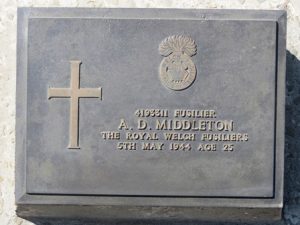
Mathew Frank Morris, MM, Serjeant, 1905889, Royal Engineers. Mathew was the son of Alfred H. Morris and Louisa Morris, of Gasworks House, Tywyn. He was the husband of Maud Morris, of Station Town, Co. Durham. Frank enlisted into the Royal Engineers, but later volunteered to serve with the Commandos, and after undergoing his training at Achnacarry, was posted to No 1 Commando. He served in North Africa with 1 Commando, taking part in Operation Torch and subsequent operations in Tunisia, and was awarded the MM, and later Mentioned in Despatches, in recognition of gallant and distinguished services in North Africa. No 1 Commando was later posted to Burma in November 1943, as part of 3 Commando Brigade, and fought in The Arakan at Akyab and Myebon. On 31 January 1945 No 1 Commando, together with No 5 Commando and 42 RM Commando, were in positions at Hill 170, Kangaw, when they came under attack by the Japanese. Frank was killed during the counter-attack later that morning. The 26-year-old is buried in Taukkyan War Cemetery, Myanmar. The citation for the award of his Military Medal was sent to HQ on 24 March 1943 by his CO, Lieutenant Colonel Tom Trevor, and read: ‘On March 17th, 1943, Cpl. Morris, with a small party were detailed to assist in clearing out an isolated enemy post in a wood in the area of Tamera Mine. At approximately 17.30 hrs the area was attacked and the enemy driven out by Cpl Morris and the seven men with him. After the attack one of Cpl Morris’s men, Pte Austin, was wounded by a burst of automatic fire that came in from a flank. Austin could not move and so Cpl Morris went back into the open and succeeded in bringing in the wounded man and carried him until he was able to hand him over to a stretcher party. Cpl Morris did not hesitate to go for Austin in spite of the fact that he realised he was under observation and within very close range of an enemy automatic weapon. This action of Cpl Morris was consistent with the energetic leadership and good example Morris has set while in command of a sub-section.’
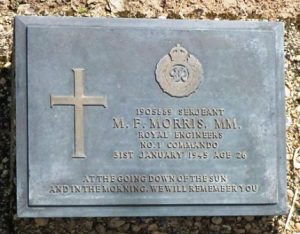
Robert Graham Roberts, Pilot Officer, 49565, Royal Air Force. Robert was the son of Leonard Llewelyn Roberts and Mary Jane Roberts (nee Graham), of 7, Red Lion Street, Tywyn. He enlisted into the Royal Air Force, and was posted to 18 Squadron, RAF. The Squadron was originally equipped with the Bristol Blenheim, based at RAF Upper Heyford, before going to France as part of the BEF Air Component. It originally carried out reconnaissance work, but following the German invasion carried out strategic bombing missions before evacuating to England on 19 May 1940, and moving to RAF Watton in Norfolk. It then carried out anti-shipping duties, and on one raid an aircraft from the Squadron dropped a box over St Omer airfield containing an artificial leg for Wing Commander Douglas Bader. The squadron then moved to North Africa with the Blenheim V to take up day bombing duties. On 25 April 1943, Robert was flying aboard a Douglas Boston, Serial AL797 when the aircraft collided with AL747 and crashed two miles from Teboursouk, Tunisia, killing all four of her crew. Robert was 23 years old when he was killed in the crash, and is buried alongside his three comrades in Thibar Seminary War Cemetery, Tunisia.
William Ivor Roberts, Lance Corporal, 4183946, Corps of Military Police. William was born on 8 February 1905, the son of Thomas and Mary Ellen Roberts, of Tywyn. He married Clara Gladys Pryce in 1927. William enlisted into the army following the outbreak of war and was posted to the Corps of Military Police. William died whilst on duty in Essex on 5 July 1944, just the day before D-Day. The 39-year-old was brought home for burial in Tywyn Cemetery.
John Cuthbert Stivey, Third Officer, Merchant Navy. John was born at Liverpool on 24 March 1909, the son of Commander John Stivey, Royal Naval Reserve, and of Annie Stivey (nee MacReavey). The family came to live at 4, Marconi Bungalows, Tywyn some years prior to the war. John was a seaman, and served in the Merchant Navy. He was married to Evelyn Stivey, of Cathcart, Glasgow, presumably after meeting her whilst based in the Clyde. John served aboard HMTS Alert, a Telegraph, or Cable, Ship. On 24 February 1945, Alert was at work in the Chanell, repairing the Broadstairs to La Panne communication cable, when she was lost with all hands. She appears to have been sunk by a two-man German midget submarine. John was 35 years old when he died that day, and is commemorated on the Tower Hill Memorial, London.
Evelyn Eileen Williams, Leading Wren, 1160, Women’s Royal Naval Service. Evelyn was born in Penrhyndeudraeth on 3 July 1921, the daughter of Watkin Dresser Williams and Doris Evelyn Williams (nee Morgan). Her father had served in WW1, before joining the Police and had been a Police Sergeant at Tywyn prior to the war. Evelyn enlisted into the Women’s Royal Naval Service, and was attached to HMS Monck, the Combined Forces training establishment at Largs. She was attached to the landing carrier training centre at Port Glasgow. Evelyn took ill whilst based there and died of Bronchiectasis at Hairmyres Hospital, near Glasgow on 21 January 1945, aged 23. Her remains were brought home for burial in St. Twrog Churchyard, Maentwrog.